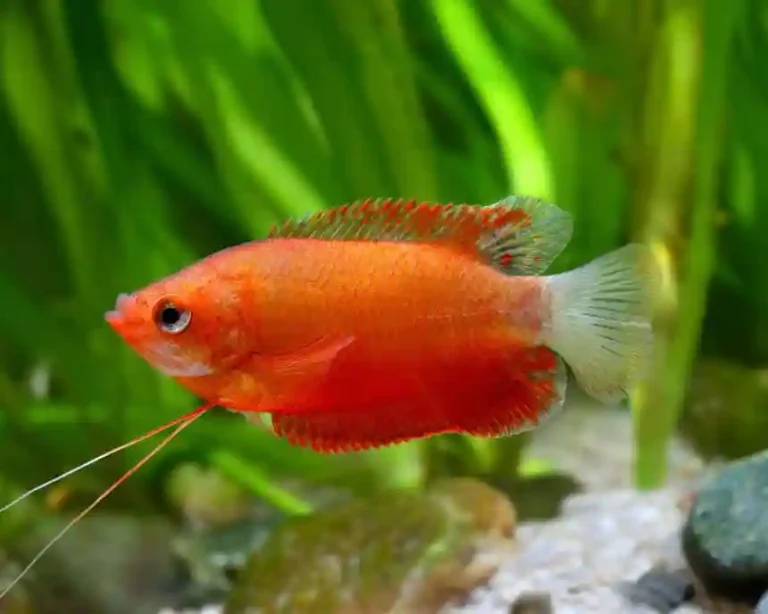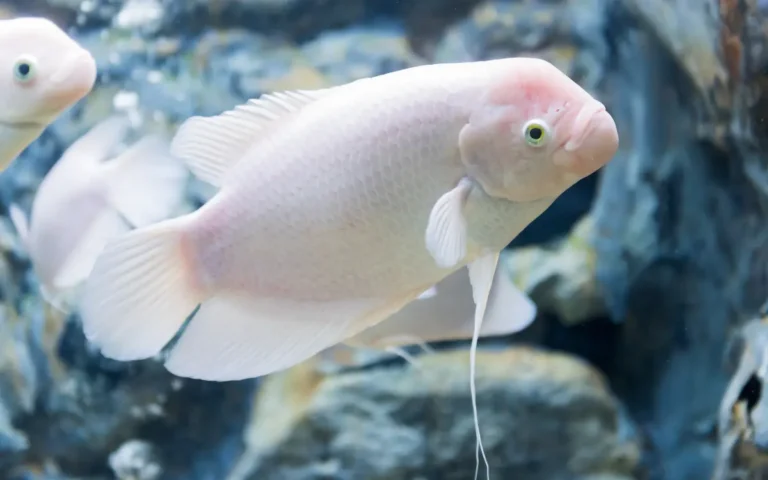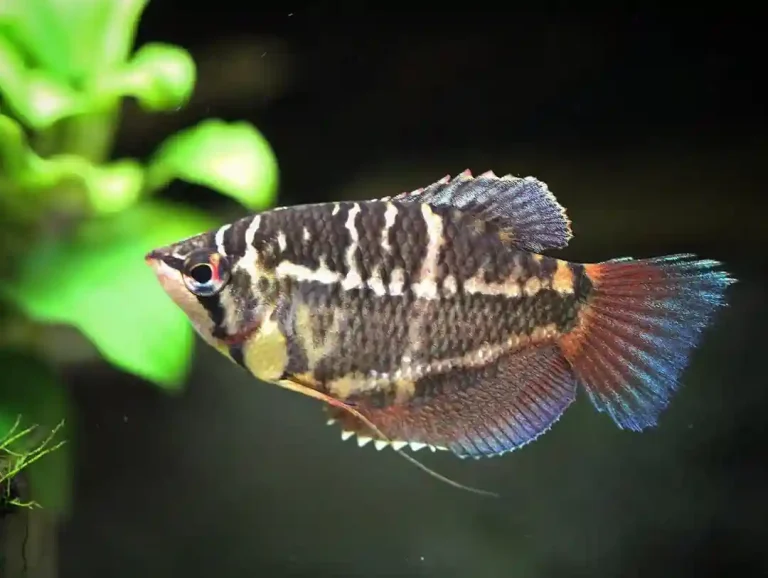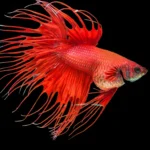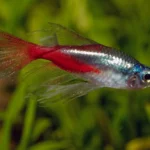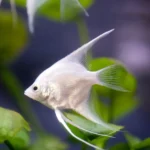Are you fascinated by the colorful underwater world of clownfish? These charming little fish captured the hearts of millions after their starring role in a certain animated film, but there’s so much more to them than their celebrity status!
In this comprehensive guide, we’ll explore the various types of clownfish, their unique characteristics, and what makes each species special. Whether you’re a seasoned aquarist planning your next tank addition or simply curious about these vibrant ocean dwellers, you’ll find everything you need to know about the wonderful world of clownfish.
What Are Clownfish?
Clownfish, also known as anemonefish, are small, brightly colored marine fish belonging to the subfamily Amphiprioninae within the family Pomacentridae. With approximately 30 recognized species primarily classified into two genera (Amphiprion and Premnas), these fish are among the most recognizable in the ocean.
Native to the warm waters of the Indian and Pacific Oceans, including the Great Barrier Reef and the Red Sea, clownfish have adapted to life in shallow reefs and lagoons. What makes them truly fascinating is their remarkable symbiotic relationship with sea anemones—a partnership we’ll explore in detail later.
Most Popular Clownfish Species
Let’s dive into the most popular clownfish species that you might encounter in aquariums or during underwater adventures.
1. Ocellaris Clownfish (Amphiprion ocellaris)
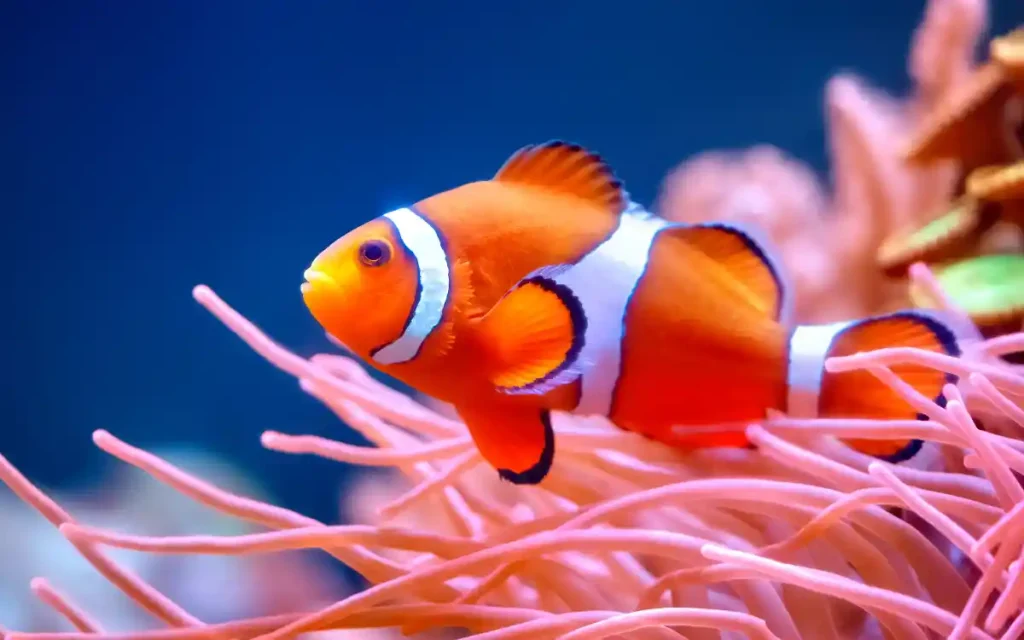
The Ocellaris Clownfish, often called the “False Percula” or “Common Clownfish,” is what most people picture when thinking of clownfish. Here’s why they’re so popular:
- Appearance: Bright orange body with three white bars outlined in black
- Size: Typically grows to about 3-4 inches (7-10 cm) in length
- Temperament: Generally peaceful and adaptable
- Care Level: Beginner-friendly
The Ocellaris is often confused with the Percula Clownfish due to their similar appearance, but you can tell them apart by looking at their dorsal fins—the Ocellaris has 11 spines, while the Percula has 10.
2. Percula Clownfish (Amphiprion percula)
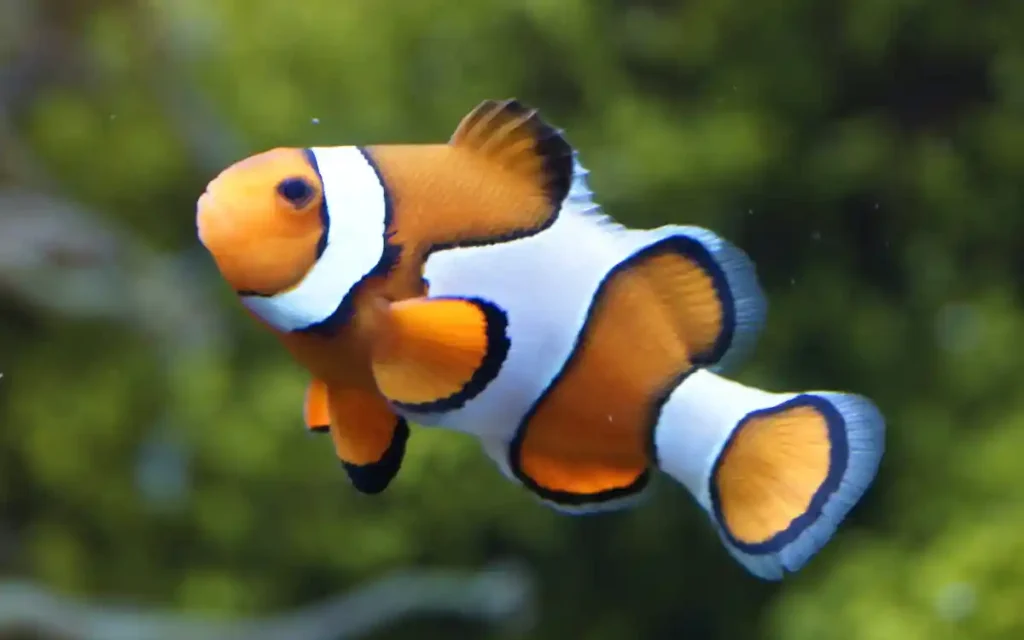
The “True Percula” Clownfish is slightly less common in aquariums than its Ocellaris cousin but is prized for its vibrant coloration.
- Appearance: Rich orange body with three white bars featuring thick black edges
- Size: Slightly smaller than the Ocellaris, usually 3-3.5 inches (7-9 cm)
- Temperament: Peaceful but can be territorial around their anemone
- Care Level: Beginner to intermediate
True Perculas typically have a more vibrant orange color and thicker black margins around their white bands compared to Ocellaris.
3. Maroon Clownfish (Premnas biaculeatus)

The Maroon Clownfish stands out from other species in both appearance and temperament:
- Appearance: Deep maroon or burgundy body with three white or gold vertical stripes
- Size: One of the largest clownfish species, reaching up to 6.5 inches (17 cm)
- Temperament: Known for being more aggressive and territorial
- Care Level: Intermediate to advanced
As the only member of the genus Premnas, the Maroon Clownfish is distinctive not just for its coloration but also for the prominent spines on its gill covers, which are used for defense.
4. Clarkii Clownfish (Amphiprion clarkii)
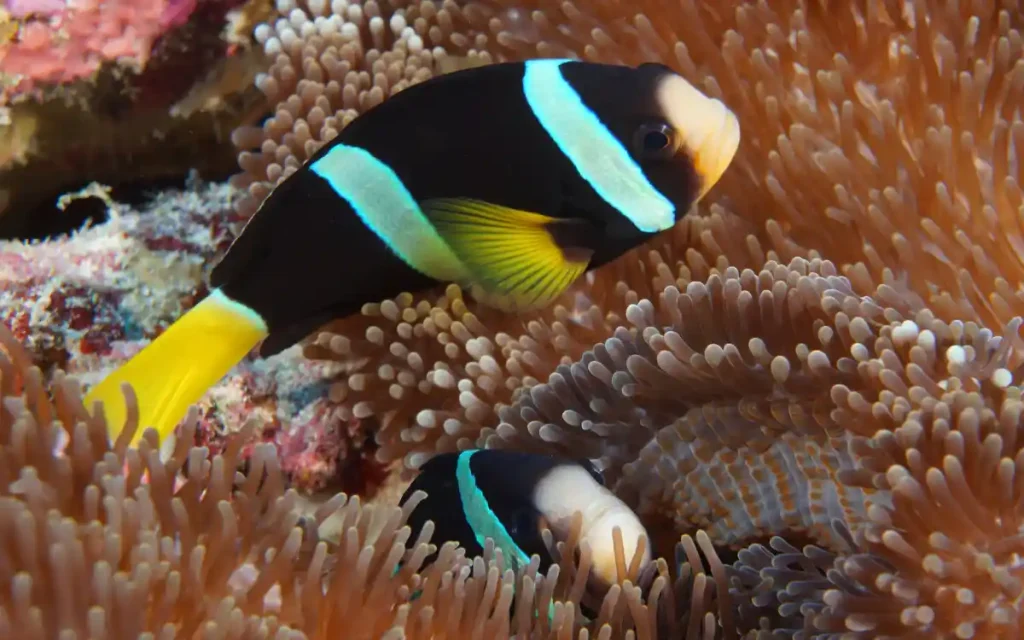
The Clarkii Clownfish, sometimes called the “Yellowtail Clownfish,” is one of the most adaptable species:
- Appearance: Color varies widely from yellow to brown, typically with two white bands and a yellow tail
- Size: Medium-sized, growing to about 4-5 inches (10-13 cm)
- Temperament: Semi-aggressive, especially as they mature
- Care Level: Beginner to intermediate
The Clarkii is notable for its ability to adapt to a wide range of anemone species in the wild, making it one of the most versatile clownfish.
5. Tomato Clownfish (Amphiprion frenatus)
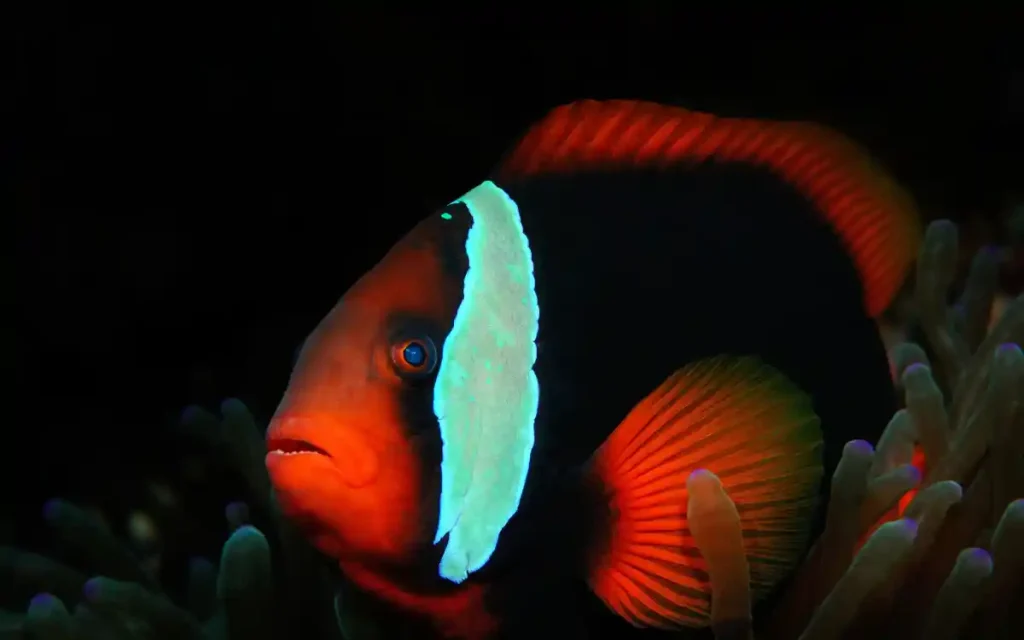
With its bold coloration, the Tomato Clownfish makes a striking addition to any marine aquarium:
- Appearance: Bright red-orange body with a single white bar behind the eye
- Size: Medium-sized, typically 4-5 inches (10-13 cm)
- Temperament: Can be aggressive, especially males
- Care Level: Intermediate
The Tomato Clownfish is hardy and relatively easy to care for, though its more territorial nature means it needs appropriate tank space.
Comparison of Popular Clownfish Species
Here’s a helpful comparison table of the most common clownfish species to help you decide which might be right for your aquarium:
| Species | Size | Coloration | Temperament | Difficulty | Ideal Tank Size |
| Ocellaris | 3-4″ | Orange with 3 white bands | Peaceful | Beginner | 20+ gallons |
| Percula | 3-3.5″ | Bright orange with 3 white bands | Peaceful | Beginner | 20+ gallons |
| Maroon | 6-6.5″ | Maroon with 3 white/gold bands | Aggressive | Advanced | 50+ gallons |
| Clarkii | 4-5″ | Yellow/brown with 2 white bands | Semi-aggressive | Intermediate | 30+ gallons |
| Tomato | 4-5″ | Red-orange with 1 white band | Semi-aggressive | Intermediate | 30+ gallons |
Less Common Clownfish Varieties
Beyond the popular species, there are several fascinating but less common clownfish varieties that deserve attention:
6. Pink Skunk Clownfish (Amphiprion perideraion)
The Pink Skunk Clownfish features a pale pink or orange body with a single white stripe running from its snout along its back. These peaceful fish grow to about 3 inches and are known for their shy nature.
7. Saddleback Clownfish (Amphiprion polymnus)
With its unique black and white pattern resembling a saddle, this species stands out from its more colorful relatives. They can grow up to 5.5 inches and have a moderately aggressive temperament.
8. Cinnamon Clownfish (Amphiprion melanopus)
Named for its reddish-brown or “cinnamon” coloration, this species features a single white band behind the head and grows to about 5 inches. They’re known for being quite aggressive, especially in smaller tanks.
Designer Clownfish Varieties
Recent advances in selective breeding have led to stunning “designer” varieties of clownfish with unique patterns and colors not found in the wild:
Snowflake Clownfish
A variation of the Ocellaris Clownfish, Snowflakes feature irregular, snowflake-like patterns on their white bands that sometimes extend across their bodies.
Black and White Ocellaris
These striking fish have the same pattern as regular Ocellaris but with a black and white color scheme instead of the traditional orange.
Picasso Clownfish
Named after the famous artist, these fish display irregular white patterns that extend beyond the typical bars, creating a unique, painterly effect on their bodies.
The Amazing Clownfish-Anemone Relationship
One of the most fascinating aspects of clownfish is their symbiotic relationship with sea anemones. This partnership benefits both creatures:
Benefits for the Clownfish:
- Protection from predators among the anemone’s stinging tentacles
- A safe place to lay eggs and raise young
- Access to food particles trapped by the anemone
Benefits for the Anemone:
- Cleaning of parasites and debris
- Protection from anemone-eating predators
- Improved water circulation around the anemone
- Nutrients from clownfish waste
How Do Clownfish Avoid Getting Stung?
Clownfish have developed a special mucus coating that protects them from an anemone’s stinging cells. This immunity isn’t immediate—young clownfish gradually acclimate to their host anemone through a careful “dancing” ritual, slowly building up their protective coating.
Clownfish Behavior and Biology
Social Structure
Clownfish live in hierarchical groups with a strict pecking order:
- The largest female is dominant and mates with the largest male
- Smaller males remain non-breeding
- If the female dies, the breeding male will change sex and become female
- The largest non-breeding male will then mature to become the new breeding male
This ability to change sex (protandrous hermaphroditism) is one of the most fascinating aspects of clownfish biology.
Breeding Habits
Clownfish are relatively easy to breed in captivity, which contributes to their popularity among hobbyists:
- A mated pair will clean a flat surface near their anemone
- The female lays 100-1,000 eggs depending on species and size
- The male fertilizes the eggs
- The male becomes the primary caretaker, fanning and guarding the eggs
- Eggs typically hatch after 6-8 days
- Larvae float in the water column for 8-12 days before settling
Keeping Clownfish in Home Aquariums
Tank Requirements
If you’re considering keeping clownfish, here are the basic requirements:
- Tank Size: Minimum 20 gallons for most species, larger for more aggressive varieties
- Water Parameters:
- Temperature: 74-79°F (23-26°C)
- pH: 8.1-8.4
- Salinity: 1.020-1.025 specific gravity
- Filtration: Good quality protein skimmer and mechanical filtration
- Lighting: Moderate to high depending on if you keep anemones
- Decor: Live rock for hiding places and natural algae growth
Do Clownfish Need Anemones in Captivity?
While clownfish and anemones have a fascinating relationship in the wild, clownfish do not require anemones to thrive in captivity. In fact, many marine aquarists successfully keep clownfish without anemones since the anemones themselves can be challenging to maintain.
If you do want to recreate this natural partnership, research carefully—specific clownfish species prefer specific anemone species. Some more aquarium-friendly anemone options include:
- Bubble Tip Anemone (Entacmaea quadricolor)
- Magnificent Sea Anemone (Heteractis magnifica)
- Carpet Anemone (Stichodactyla gigantea)
Feeding Your Clownfish
Clownfish are omnivores with a varied diet:
- Commercial Foods: Quality marine flakes and pellets
- Frozen Foods: Mysis shrimp, brine shrimp, bloodworms
- Fresh Foods: Small pieces of seafood like shrimp or clam
- Vegetable Matter: Seaweed sheets, spirulina
Feed small amounts 2-3 times daily rather than one large feeding.
Common Health Issues
Keep an eye out for these common clownfish health problems:
- Ich (White Spot Disease): Appears as white spots on body and fins
- Marine Velvet: Gold/rust colored dusty appearance on skin
- Brooklynella: Causes excess mucus production and respiratory distress
- Bacterial Infections: Often appear as red streaks or open sores
Regular water quality testing and maintenance are your best defense against these issues.
Conservation Status
Wild clownfish populations face several threats:
- Collection for the aquarium trade (though many are now captive-bred)
- Coral reef destruction through bleaching events, pollution, and climate change
- Ocean acidification affecting anemone health
By choosing captive-bred specimens for your aquarium, you help reduce pressure on wild populations.
Conclusion
Clownfish are fascinating creatures that bring color, personality, and interesting behavior to any marine aquarium. From the popular Ocellaris to the less common designer varieties, there’s a clownfish to suit every aquarist’s preference and experience level.
Whether you’re drawn to their bright colors, unique relationship with anemones, or their fascinating life cycle, clownfish continue to be some of the most beloved inhabitants of the marine aquarium hobby.
Have you kept clownfish in your aquarium? Which species is your favorite? Share your experiences in the comments below!
FAQs About Clownfish
Q: How long do clownfish live? A: With proper care, clownfish can live 6-10 years in captivity, with some specimens reaching 15+ years.
Q: Are clownfish difficult to keep? A: Common species like the Ocellaris and Percula are considered beginner-friendly marine fish, making them good options for those new to saltwater aquariums.
Q: Can different clownfish species live together? A: It’s generally not recommended to keep different clownfish species in the same tank unless it’s very large, as they will likely fight for territory.
Q: How can I tell male and female clownfish apart? A: Females are typically larger than males. In a mature pair, the female can be significantly bigger than her mate.
Q: Do clownfish need to be kept in pairs? A: While clownfish do form pairs in the wild, they can be kept singly or in small groups (depending on tank size) in captivity.

